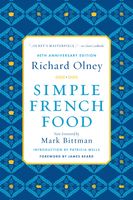Advertisement
Veal Scallops
Escalopes de Veau
Appears in
Published 1974
Veal is the most versatile of meats; its succulent juices, the flesh colored in a bit of fat, rapidly caramelize to form, when de-glazed, the finest of simple meat-sauce bases; the flavor, apparently anonymous in its lack of eccentricity, is nonetheless of a sapid density and a chameleon receptivity that demand only the spark of one or a combination of other agents—wine, lemon, sorrel, mustard, herbs, aromatic vegetables—to open up a sharply defined personality. Thick chops or a small roast from a moist cut—round heel, for instance—cooked gently in a covered heavy pan, copper, earthenware or iron, in a bit of butter or olive oil with pieces of onion or whole small onions, carrot, unpeeled garlic cloves, a bouquet or a pinch of herbs, turned regularly and, once the meat and vegetables have begun to color and caramelized scrapings have formed in the bottom of the pan, moistened lightly with a white wine or one of the fortified wines, will eventually, after repeated moistenings, be enveloped in a voluptuous, syrupy glaze that is one of the glories of old-fashioned French home cooking. The process is one of repeated deglazing. The liquid must be added in small quantities at a time, never more than a film in the bottom of the pan, and it should be permitted to completely evaporate, caramelized adherences beginning to re-form in the pan before more is added. After the first couple of deglazings, it is best to substitute water or veal stock for the wine, particularly if it is one of the richly flavored fortified wines—and a close eye should be kept throughout, for a sumptuous glaze may, in a moment’s time, be transformed into an acrid disaster should any element begin to burn . . .


